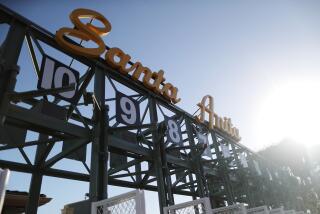Santa Anita racetrack played a role in WWII internment
- Share via
A plaque near the entranceon the sprawling grounds of the Santa Anita racetrack is the sole reminder of the track’s place in World War II history as the nation’s largest assembly center for Japanese Americans on their way to internment camps.
Although the prestigious Breeders’ Cup World Championships unfolded Friday and Saturday at the landmark racetrack, 67 years ago a darker chapter unfolded at the site. The horses were moved out, the track was shut down and the park’s extensive grounds provided the massive space needed by the War Department to temporarily house thousands of people of Japanese decent.
The Arcadia Historical Museum has chronicled the track’s use as a camp in an exhibit titled “Only What We Could Carry: The Santa Anita Assembly Center.” The show, which opens Nov. 10 and runs through Jan. 16, features photos, stories and other artifacts.
Dana Dunn, the museum’s curator, said she created the exhibit after learning that many in the community were unaware of the racetrack’s past use.
“I’m hoping that everyone will leave with a better understanding of our American past on this topic and that it will bring about some collective healing and cultural understanding,” she said.
After the bombing of Pearl Harbor on Dec. 7, 1941, President Franklin D. Roosevelt ordered the evacuation of Japanese Americans to internment camps. While these relocation camps were being built, evacuees were ordered to stay for a few months at assembly centers throughout California, as well as in Arizona, Oregon and Washington.
Beginning in March 1942, about 19,000 Japanese Americans from Southern and Northern California lived at Santa Anita in hastily constructed barracks or in converted horse stalls, which some evacuees said never fully lost the stench of manure.
The Army covered Santa Anita’s parking lot with row after row of identical barracks covered with tar paper. The camp was divided into seven districts and included several mess halls, a hospital, stores, a post office, classrooms, and makeshift churches in the track’s grandstand.
Each evacuee was given an Army bed, one blanket and one straw tick, according to Anthony Lehman, author of “Birthright of Barbed Wire.” The racetrack was surrounded by barbed wire.
At night, searchlights swept the streets.
Residents were banned from possessing any literature printed in Japanese.
At the center, many Japanese Americans found work, some in their chosen professions, as doctors, teachers, cooks, electricians and typists. Others worked in the track infield, which was turned into a vegetable garden to supplement meals.
Despite the repressive environment, internees formed theater groups, knitting classes, a choir, a band and a string quartet.
The camp had more than 70 softball teams, half a dozen Boy Scout troops and a PTA.
For the most part, the center ran smoothly, with little dissent. However, in August 1942, soldiers rushed in to quell a riot after a suspected informant was beaten. The internee’s injuries were not serious, and three days later the military police withdrew, The Times reported.
The evacuees also left another vibrant record, a newspaper called the Santa Anita Pacemaker, which is preserved at the Arcadia Public Library and will be on display at the museum exhibit.
Written in English by a staff of Japanese Americans interned in the camp, the Pacemaker came out twice a week on four to six mimeographed pages. The staff found enough editorial wiggle room to put their own creative stamp on the publication.
The first issue, on April 18, had no name, just three question marks where the name should be. An accompanying story, “We’re stumped -- lend us a hand,” called for readers to name the paper. In the next issue, the paper reported that after discussing the 41 submissions, the staff picked “Pacemaker” by a two-vote margin over “Thoroughbred.”
Explaining the name, Editor Eddie Shimano stated, “This newspaper is supposed to set the pace for the Japanese at the center. . . . A pacemaker in a horse race is the horse that leads the way for the others to a certain point, and that’s what we are going to do.”
A typical issue reported official announcements, such as one ordering evacuees to return their plates and utensils to the mess hall or else their barracks would be searched. It also included society news of births, birthday parties and club meetings, and in-camp sports reports.
The paper ran a regular women’s column, dubbed “Feminine Forum,” in which writer Asami Kawachi dispensed practical advice, such as how to wash hair when shampoo wasn’t available.
The paper’s content probably had to be approved by camp officials, said Mary Beth Hayes, a reference supervisor at the Arcadia library, but she did not know the extent of the censorship.
The paper’s editors did, however, manage to slip in some subversive humor. When it profiled a Japanese American family from Arcadia interned at Santa Anita, the tongue-in-cheek headline read, “It Wasn’t Much of A Move.”
The paper even managed to make a name for itself in journalism circles.
“The Pacemaker is an example of human ingenuity lifted to a peak,” wrote the Los Angeles Herald Express.
By September 1942, camp members had begun to depart from Santa Anita for different relocation centers.
Shimano published the final 50th edition on Oct. 7. By the end of the month, the Santa Anita camp was empty.
The racetrack then took on another wartime assignment, as an Army training camp.
More to Read
Sign up for Essential California
The most important California stories and recommendations in your inbox every morning.
You may occasionally receive promotional content from the Los Angeles Times.










